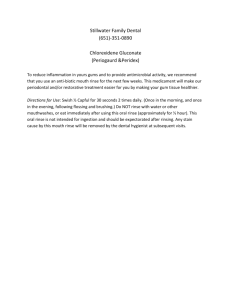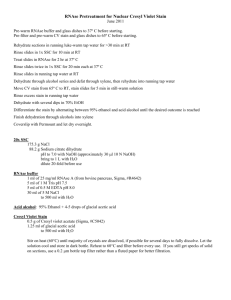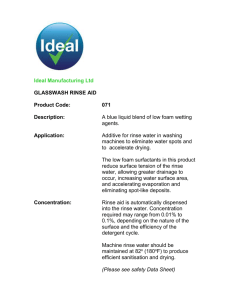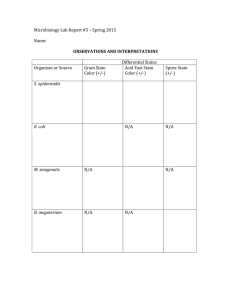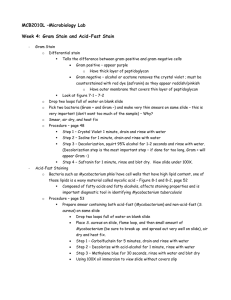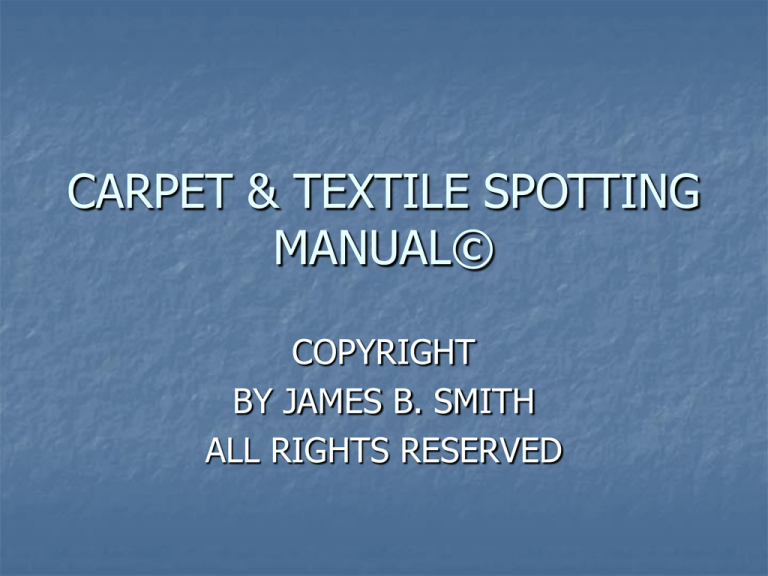
CARPET & TEXTILE SPOTTING
MANUAL©
COPYRIGHT
BY JAMES B. SMITH
ALL RIGHTS RESERVED
OVERVIEW
I.
DEFINITIONS/RULES
II.
CHEMICAL TERMS
III.
TOOLS OF THE TRADE
IV.
PRE-INSPECTION & IDENTIFICATION
V.
TYPES OF SPOTS
Water soluble
Solvent Soluble
Insoluble
Dye & Pigment
Penetrating
Damaging
Spots That Are Difficult To Remove
VI.
OXIDIZERS & REDUCERS
VII.
TECHNIQUES IN REMOVING
VIII. SPOTTING CHART
I.
DEFINITIONS
Definitions from the S001-1994 CLEANING STANDARD says this about spots and stains:
Page 37
spot - The result of a material adding substance or texture to a fabric or surface. Usually the
terms "spot" and "stain" are used interchangeably in a non-technical context.
spotting - The process of treating isolated spots and stains, that do not respond to normal
cleaning with, specifically formulated agents.
stain - the result in a material adding color (without texture) to a fabric or surface, in a nontechnical context. The term "stain" is often applied to discoloration, or color removal from
fabrics, as well.
Consumer responsibility for spots and stains in the S001-1994 CLEANING STANDARD says
this:
3. Immediate Spotting - Most spots can be removed easily if the excess is lifted or blotted and
treated immediately by carpet owners with plain water, or with spotters containing mild (pH range
of 5 to 9), dilute detergents that do not leave residue. If ignored those spots, or components
thereof, may bond with fiber dye sites, forming permanent stains. Immediate spotting is an
essential responsibility for home and business owners/managers.
Concerning what the consumer can expect from the cleaner is says this on page 8:
g. Special attention to spots and stains must be included in normal job performance. However,
time consuming specialized spotting of quantities of spilled materials or prolonged effort on coloradded spots may incur an additional charge. Customers should be advised of additional charges
before extensive spotting procedures are undertaken.
Rules for Spotting
.APPEARANCE - Spots that are lighter than the surrounding unaffected area
are the result of color loss. Spots that are darker than the surrounding
unaffected areas are the result of something added. Spots that end-up
changing in different light and diminish or disappear in direct intense light
are the result of texture variations, usually from over aggressive mechanical
action.
.HEALTH & SAFETY - Protect yourself with gloves, face mask, and respirator
when using dangerous chemicals. Dangerous chemicals such as
Erusticator, and strippers, and some solvents should be rinsed out
completely after using.
.CHEMICALS - Physically remove as must excess of the spot as possible
before adding chemicals. VDS is the first chemical to use on an unknown
spot. Strong oxidizers, strippers are the last chemicals to use.
.APPLICATION - Do not distort the texture of the fiber. Tap and blot, do not
brush and rub. Work from the outside of the spot to the inside. Blot up
excessive usage of chemicals. Wait to evaluate the results.
I.
Chemical Terms
ACETIC ACID- Acetic acid, HC2 H3 O 2 , pH 2.4, is a self neutralizing, evaporating acid of which white
vinegar is a 5 to 7% solution. White vinegar can be made into a tannin spotter by mixing it with two
parts water. Professional concentrations of acetic acid vary from 5 to 28%.
Acetic acid is most suitable for applications that require starting with an acid and then switching to
an alkaline or vise-versa. It is not a satisfactory remedy for pH problems on yellowing and indicator
dyes.
AMMONIA & AMMONIUM HYDROXIDE - Ammonia, (NH3 ) is a gas while ammonium hydroxide,
(NH4 OH), is an alkaline liquid. Ammonium hydroxide will self neutralize its pH after being applied to
a textile.
Ammonium hydroxide is not a suitable for correcting problems with acid residues such as in the
case of color changes from indicator dyes.
ENZYMES - The enzyme component of a spotter or prespray is an extract from a live microbe, but
is not a living thing. Two advantages that distinguishes enzymes from other detergent components
are:
it decomposes components of soil with no effects on the textile
it is not used up or consumed in the process.
This is in contrast to alkali, solvents, and surfactants that can cause ill effects on the textile and are
consumed in the process of removing soil.
Disadvantages of enzymes are they will slow down or stop working if the pH and temperature are
not right. With the arrival of Enzyme Presprays, the pH of many products is much higher than the
products of the 80’s.
HYDROGEN PEROXIDE - Hydrogen peroxide (H2O2), is a liquid that is
made from O-Zone (O3) reacting with water, (H2O). The result is a medium
strength acid oxygen bleach that is suitable for spotting textile in
concentrations under 5%. Hydrogen peroxide does its work when it breaks
down and can be accelerated by adding a trace of ammonium hydroxide.
Phosphoric acid will stabilize hydrogen peroxide and prevent it from
reacting and acetic acid will react making a new compound called peracetic acid. Per-acetic acid can bleach the color from nylon and should be
considered a strong oxidizer. Hydrogen peroxide left un-reacted can
increase in concentration in the drying process causing damage to textiles,
specially on natural fibers such as cotton.
pH - pH is the standard method for describing acidity or alkalinity. It is a
scale that starts with 0 and goes to 14, with 7 being neutral or pure water.
Below 7 is an acid and above 7 an alkaline. A change of one represents a
10 fold increase or decrease in the amount of acidity or alkalinity.
Expanded understanding of acids and alkalines reactions includes
information on molar strengths, (concentrations) and the reactivity, (G).
For example sulfamic acid has a very low pH of 0.47, but is not very
reactive.
SODIUM PER-CARBONATE - Sodium per-carbonate is a powder, alkaline, oxygen bleach that is made
from hydrogen peroxide and soda ash. It is suitable as a detergent booster or spotting agent. Sodium
per-carbonate can leave an alkaline residue in excess of pH 11.
VOLATILE DRY SPOTTER, (VDS) - Commonly this product is or was 1,1,1 trichloroethane, (CH3CCl3)
which is a slightly flammable, fast evaporating dry-solvent. Due to changes in the law, newer Volatile Dry
Spotters are blends of possibly more toxic and/or flammable solvents. Volatile Dry Spotter should be the
first spotter used on an unknown spot. It is not totally effective on paint without the help of non-volatile
solvents.
NON-VOLATILE DRY SPOTTER, (NVDS) - Commonly referred to as POG or PAINT, OIL, & GREASE
REMOVER, is a blend of solvents that is mixed into a crude refinement of petroleum. As such, some of
this blend will not. Evaporate completely. Non-Volatile Dry Spotter slows down the evaporation rate of
Volatile Dry Spotter and is an essential step in removing some forms of paint. Some newer products are
more ‘gel like’ and are made of blends of water and d-limonene.
SPOTTING KIT CHECK LIST
A.
Regular
1.
VDS- Volatile Dry Spotter
2.
NVDS - Non-Volatile Dry Spotter
3.
General Spotter - neutral pH
4.
Alkaline Spotter
5.
Enzyme Spotter
6.
Tannin Spotter
7.
Ammonium Hydroxide
8.
Hydrogen Peroxide
9.
Sodium Percarbonate
10.
Bisulifite or Coffee Stain Remover
11.
Rust Remover
12.
Towels
13.
Bone Scrapper
SPOTTING KIT CHECK LIST
A.
ADVANCED
1.
Steam Iron
2.
Steam Gun
3.
Sodium Hydrosulfite
4.
Strong Oxygen Bleach
PRE-INSPECTION & IDENTIFICATION
A.
The first step in identification is to ASK the consumer what the
stain is.
B.
The second step comes from SIGHT.
1.
A splash or irregular pattern likely came from something spilt.
2.
A pattern such as circular or rectangular probably came from
something laid on the surface.
3.
A shiny stain is likely from
a)
Hardened Oil
b)
Paint
c)
Varnish
d)
Nail Polish
4.
A dull appearance that lightens when scratched is likely from
food.
5.
A spot that is lighter than its surrounding was likely caused by
a bleaching agent or from color loss.
A. The third step comes from TOUCH. Categories for touch
are as follows: crusty, hard, soft, tacky, oily, wet, and waxy.
B. The fourth step comes from SMELL. This may be the
best instrument for identification, but it is subjective too.
Also, caution should be given concerning inhaling toxins
from chemicals and bacteria.
C. pH is important when a spot does not respond to
solvents. pH reading from an electronic instrument will
likely be less than those taken from paper or strips. This is
so because moisture on paper or strips will ultimately
measure the dry pH while pH Pens measure a diluted pH at
the time of the reading.
I.
TYPE OF STAINS
A.
Water Soluble Stains
1.
2.
Respond to acids
a)
Beer
b)
Cocktails
c)
Wine
Respond to alkaline
a)
Soil
A.
Dry Solvent Soluble Stains
1.
2.
Volatile Dry Solvent Types
a)
Tar
b)
Grease
Non-Volatile Dry Solvent types - Paint
A.
Insoluble Stains
1.
Food that relate to Enzymes
a)
Blood
b)
Catsup & Tomato Sauce
c)
Chocolate
d)
Cough Syrup
e)
Egg (Raw)
f)
Gravy
g)
Grass
h)
Jelly & Jam
i)
Ice Cream
j)
Mercurochrome
k)
Mildew
l)
Milk
m)
Mucilage
n)
Mustard
o)
Soft Drinks
p)
Urine
q)
Vomit
r)
Wine
1.
Other insoluble that relate to Vacuuming
a)
Copy machine toner
b)
Fingerprint dust
A.
Pigment type stains that relate to oxidizer and reducer or heat
transferred technique
1.
Coffee
2.
Dye
3.
Tea
4.
Medicine
5.
Rust
6.
Urine
A.
PENETRATING STAINS
1.
Coffee
2.
Tea
3.
Urine
4.
Dye
A.
DAMAGING STAINS
1.
Strong Bleaches
2.
Strong Oxidizers
3.
Some Acids
A.
SPOTS THAT ARE DIFFICULT TO REMOVE
1.
Very Difficult
a)
Asphalt Tracking
b)
Food Coloring
c)
Grass
d)
Mustard
e)
Paint
f)
Soot
g)
Urine
h)
Yellowing (some forms)
i)
Wine
1.
Likely Impossible
a)
Furniture Stain
b)
Ink, depends upon type
c)
Mercurochrome
d)
Mustard after it has reacted with alkali
Stains that set with heat
a)
Blood
b)
Catsup & Tomato Sauce
c)
Chocolate
d)
Milk
e)
Soft Drinks?
f)
Urine especially on wool
Stains that set with alkali
a)
Coffee on silk & wool
b)
Mustard
c)
Urine
OXIDIZERS & REDUCERS
A.
TYPES OF REDUCERS
1.
Sodium Thio-Sulfite - bleach neutralizers
2.
Sodium Meta-bisulfite - coffee stain removers
3.
Sodium Hydrosulfite - red stain remover
4.
Rust stain remover
A.
TYPE OF OXIDIZERS
1.
Hydrogen Peroxide - coffee stain removers
2.
Sodium PerCarbonate - a detergent booster
A.
RULES
1.
Make hydrogen peroxide work faster with ammonium
hydroxide
2.
Speed up acid reducers with acids or tannin spotter
3.
Stop an oxidizer with a mild reducer and vise-versa
4.
Rinse strong oxidizers and reducers after using
5.
Wait until spot is dry to evaluate the results
A.
WARNINGS
1.
Do not mix strong oxidizers and strong reducers
2.
Use the correct oxidizer or reducer for job intended
3.
Do not store ready-to-use solutions for a prolonged
time.
I.
TECHNIQUES IN REMOVING SPOTS & STAINS
A.
Just Vacuuming
1.
Copy Toner
2.
Mud After It Dries
A.
B.
Spray & Blot
1.
Browning
2.
Yellowing
Spray & Rinse
1.
Stains That Has Been Made Soluble
A.
Heat Transfer
1.
2.
Candle Wax
a)
Brown Paper Bags or Viva® or Brawny® Towels
b)
Iron
Dyes
a)
White cotton towels
b)
Iron
c)
Ammonium hydroxide or special chemical
I.
THE SPOTTING GUIDE
This section is designed for the professional cleaner with professional cleaning
products. It may not be necessary to complete all of the steps in removing some
spots, therefore do not carry out all of the chemical procedures if the spot
disappears, however always rinse or blot excessive residues and dangerous
chemicals before leaving the job.
BEER
APPEARANCE
Slightly yellow and slightly stiff
CONTAINS - Hops, malts, alcohol, albumins, tannin
1. Apply detergent solution and blot
2. Apply tannin solution and rinse
BUTADIENE
1. Apply bleach neutralizer solution such as sodium thio-sulfite
2. Blot dry
BLOOD
1. Remove as much excess as possible
2. Apply cool alkaline enzyme spotter and wait
3. Rinse with water
4. Blot
5. If stain remains apply rust remover
6. If stain still remains rinse thoroughly and apply 3% hydrogen peroxide
Do not mix rust remover and hydrogen peroxide
BUTTER & MARGARINE
1. Apply VDS Spotter
2. Extract with alkaline detergent solution
3. Apply acetic acid or tannin spotter and blot
4. Extract and blot dry
CANDLE WAX
Method 1
1. Place several brown-paper products over spot
2. Apply dry steam iron until bottom bag is saturated with wax
3. Apply fresh bag to the top
4. Repeat procedure
Method 2
1. Remove as much excess as possible
2. Apply volatile dry solvent
3. Apply POG
4. Remove as much excess as possible
5. Repeat procedure
CATSUP & TOMATO SAUCE
1. Apply cool alkaline enzyme spotter and wait
2. Rinse with water
3. Blot or extract moisture
4. If stain remains apply rust remover
5. If stain still remains rinse thoroughly and apply 3% hydrogen peroxide
Do not mix rust remover and hydrogen peroxide. A dangerous chemical reaction may
occur if you do!
CHEWING GUM
Method 1
1. Apply d-Limonene type product
2. Extract with hot water
Method 2
1. Harden the gum with ice or freon type product
2. Remove as much excess as possible
3. Apply volatile dry solvent
4. Blot or extract
CHOCOLATE
.Remove as much excess as possible
.Apply alkaline-enzyme type preconditioner
.Extract with acidic rinsing agent
.Repeat if necessary
.Blot
COCKTAILS
.Apply tannin spotter
Extract
Coffee
Method 1
.Apply tannin spotter
.Extract
Method 2 - more aggressive
.Apply sodium meta-bisulfite
.Blot or extract
If cream is present, pretreatment with enzyme may be
necessary
Alkalinizes may set stain in wool and silk
COUGH SYRUP
.Apply alkaline preconditioner
.Rinse with acidic rinsing solution
.Apply enzyme spotter
Rinse
CRAYONS
.Apply solvent base product
.Blot
Extract with detergent
EGG (Raw)
.Remove as much excess as possible
.Apply cool alkaline enzyme spotter and
wait
.Rinse with water
Dry
FOOD COLORING/DYE
Heat transfer method
.Apply ammonium hydroxide or formulated
product to affected area
.Lay wet white cotton towel on top of affected
area
.Place steam iron with water set barely in
steam mode on top of towel for 45 to 90
seconds
.Repeat as necessary
Steam Gun Method
.Apply ammonium hydroxide or formulated
product to affected area
.Apply live steam to the affected area
.Extract with hottest water possible
Reduction method
.Apply sodium hydrosulfite solution to affected
area
.Accelerate with Tannin Spotter
.Neutralize by rinsing with just water and then
a mild oxygen bleach
.Blot dry
.Professional spot dye will likely be necessary
FRUIT JUICE
.Apply alkaline preconditioner
.Rinse with acidic rinsing solution
.If stain remains; Apply enzyme spotter
Rinse
GLUE
.Apply amyl acetate, blot or rinse with an
extractor
.Repeat as necessary
GRASS
.Apply amyl acetate, blot
.Apply enzyme detergent
GRAVY
.Apply alkaline-enzyme type preconditioner
.Extract with acidic rinsing agent
Repeat if necessary
FURNITURE STAIN
Heat transfer method
.Apply POG & blot
.Apply ammonium hydroxide or formulated product to affected
area
.Lay wet white cotton towel on top of affected area
.Place steam iron with water set barley in steam mode on top
of towel for 45 to 90 seconds
.Repeat as necessary
Steam Gun Method
.Apply POG & blot
.Apply ammonium hydroxide or formulated product to affected
area
.Apply live steam to the affected area
.Extract with hottest water possible
Reduction method
.Apply POG & blot
.Apply sodium hydrosulfite solution to affected area
.Accelerate with Tannin Spotter
.Neutralize by rinsing with just water or mild oxygen bleach
.Blot dry
GREASE
1. Apply solvent base product
2. Rinse completely
3. Repeat one and two if necessary
4. Apply alkaline prespray if necessary
5. Rinse with acidic rinsing agent
ICE CREAM
1. Apply alkaline-enzyme type preconditioner
2. Extract with acidic rinsing agent
3. Repeat if necessary
INK
1. Apply solvent base or specially formulated product for removing ink
2. Rinse completely
3. Repeat one and two if necessary
4. Apply amyl acetate, if necessary
5. If stain persists, apply ammonium hydroxide or formulated product to affected area
6. Lay wet white cotton towel on top of affected area
7. Place steam iron with water set barely in steam mode on top of towel for 45 to 90 seconds
8. Repeat as necessary
JAM & JELLY
.Apply alkaline-enzyme type preconditioner
.Extract with acidic rinsing agent
.Repeat if necessary
LIPSTICK
.Apply amyl acetate or solvent based product & blot
.Repeat as necessary
.If stain persists, then apply alkaline preconditioner
.Rinse with acidic rinsing agent
MERCUROCHROME
.Apply alkaline-enzyme type preconditioner
.Extract with acidic rinsing agent
.Repeat as necessary
.If stain persists, then apply Sodium Meta-Bisulfite
Solution
.Rinse
MERTHIOLATE
.Apply bleach neutralizer solution such as sodium thiosulfite
.Blot dry
MILDEW
.Apply alkaline-enzyme type preconditioner
.Rinse
.Repeat as necessary
.If stain persists, then apply Oxygen Bleach Solution,
such as 3% hydrogen peroxide
.Blot or Rinse
MILK
.Remove as much excess as possible
.Apply cool alkaline enzyme spotter and wait
.Rinse with acidic Rinsing Solution
.If stain persists, then apply solvent based product & blot
MUCILAGE
.Remove as much excess as possible
.Apply alkaline enzyme spotter and wait
.Rinse or blot dry
MUSTARD
Method 1
.Remove as much excess as possible
.Apply neutral pH detergent solution
.Rinse with acidic rinsing solution
.Apply enzyme detergent solution, with low pH
.If stain persists, apply rust remover or 3% hydrogen
peroxide to stain, but not both. A dangerous chemical
reaction may occur if you do!
Do not apply any alkaline chemicals to this stain
Method 2
.Apply a professional spotter design for removing mustard
.Rinse or blot
NAIL POLISH
.Remove as much excess as possible
.Apply amyl acetate or solvent base product &
blot
.Repeat as necessary
.If stain persists, then apply alkaline
preconditioner
.Rinse with acidic rinsing agent
OILS
.Apply solvent based product & blot
.Repeat as necessary
.If stain persists, then apply alkaline
preconditioner
.Rinse with acidic rinsing agent
PAINT (OIL BASE)
1. Remove as much excess as possible
2. Apply POG product & blot
3. Repeat as necessary
4. If stain persists, then apply alkaline preconditioner
5. Rinse with detergent solution
6. Repeat all steps as necessary
PAINT (WATER BASE)
1. Remove as much excess as possible
2. Apply alkaline- preconditioner
3. Rinse
4. Repeat as necessary
5. If stain persists, then apply POG
6. Rinse completely
RUBBER CEMENT
1. Remove as much excess as possible
2. Apply POG product & blot
3. Repeat as necessary
4. If stain persists, then apply alkaline preconditioner
5. Rinse
RUST
1. Apply professional rust remover
2. Rinse or neutralize completely
SHOE POLISH
1. Apply solvent base product & blot
2. Repeat as necessary
3. If stain persists, then apply alkaline preconditioner
4. Rinse completely
5. if stain persists, then treat as FOOD COLORING/DYE
SOFT DRINK
1. Apply cool alkaline enzyme spotter and wait
2. Rinse with acidic Rinsing Solution
3. If stain persists, then repeat as necessary
SOOT
1. Apply solvent based product & blot
2. Repeat as necessary
3. If stain persists, then apply alkaline preconditioner
4. Rinse completely
This stain is very difficult to remove
TAR & ASPHALT
1. Remove as much excess as possible
2. Apply solvent base product
3. Repeat as necessary
4. If stain persists, then apply alkaline preconditioner
5. Rinse
TOOTHPASTE
1. Precondition with acidic detergent
2. Rinse with alkaline detergent
3. Blot dry
URINE
.Apply enzyme/bacteria type deodorizer as per manufacturer instructions
.Rinse
.Apply ammonium hydroxide solution & blot
.Apply tannin spotter & blot, phosphoric acid may work the best
.Rinse completely
.If stain persists, apply rust remover or 3% hydrogen peroxide to stain, but
not both. A dangerous chemical reaction may occur if you do!
Heat and alkalinity may set some stains especially on wool
VOMIT
.Remove as much excess as possible
.Apply alkaline-enzyme type preconditioner
.Extract with acidic rinsing agent
.Repeat if necessary
WINE
.Apply neutral pH detergent solution
.Rinse with acidic rinsing solution
.Apply alkaline enzyme detergent solution
.If stain persists, apply rust remover or 3% hydrogen peroxide to stain, but
not both. A dangerous chemical reaction may occur if you do!

